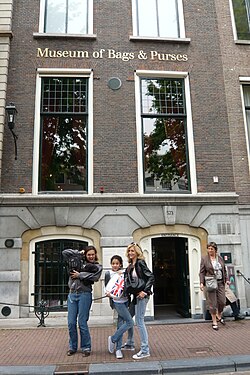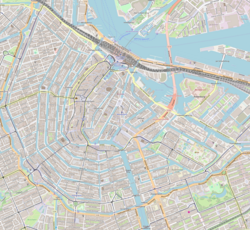Museum of Bags and Purses
| Tassenmuseum Hendrikje | |

Museum of Bags and Purses, Herengracht, Amsterdam
|
|
| Established | 1996 |
|---|---|
| Location |
Herengracht 573 Amsterdam, Netherlands |
| Coordinates | 52°21′57″N 4°53′48″E / 52.365938°N 4.896782°ECoordinates: 52°21′57″N 4°53′48″E / 52.365938°N 4.896782°E |
| Type | fashion museum |
| Visitors | 85.084 (2014) |
| Director | Sigrid Ivo |
| Website | http://tassenmuseum.nl/en/ |
The Museum of Bags and Purses (Dutch: Tassenmuseum Hendrikje), located in Amsterdam, The Netherlands, is a museum devoted to historic handbags, purses and suitcases. The museum's collection includes 4,000 items dating back to the 16th century. One of only three museums across the globe specializing in the field, and its collection is the world's largest.
While the majority of visitors to the museum are women, the most valuable item on exhibit is a sixteenth-century men's goat-skin belt pouch with iron clasps.
About 30 years ago, Hendrikje Ivo an antique dealer from Amstelveen, bought a small antique tortoiseshell bag inlaid with mother of pearl in England, dating back to 1820 and crafted in Germany. Hendrikje's interest in discovering the history of this first bag triggered a passion for collecting handbags. Before too long she had collected more than 3,000 bags. She soon decided to show part of the collection to the public. At first, the museum existed in two rooms of a villa in Amstelveen, but as the collection grew, the couple looked for a new location. Since June 2007, the museum is located in a 17th-century patrician house at the Herengracht, Amsterdam's most prestigious canal.
Today, the Museum of Bags and Purses is a serious institution with a permanent exhibition presenting the core of the collection and temporary shows of the particular designers, mostly Dutch.
The earliest handbags in the museum's collection are typically small, used to carry coins, keys and sewing kits. Such bags were carried, by both men and women, under clothing to avoid drawing the attention of thieves. The development of pants with pockets for men, and the change from billowing skirts to more form-fitting dresses, led to handbags becoming an item for women, often with elaborate adornment.
With the coming of the Industrial Revolution in the 18th century, technology and the growth of rail travel accessible to the middle class led to larger handbags, often made of durable leather.
Brand name bags came to the fore in the 1950s, epitomized by items in the collection including a quilted Chanel purse and the Hermès Kelly bag.
...
Wikipedia

